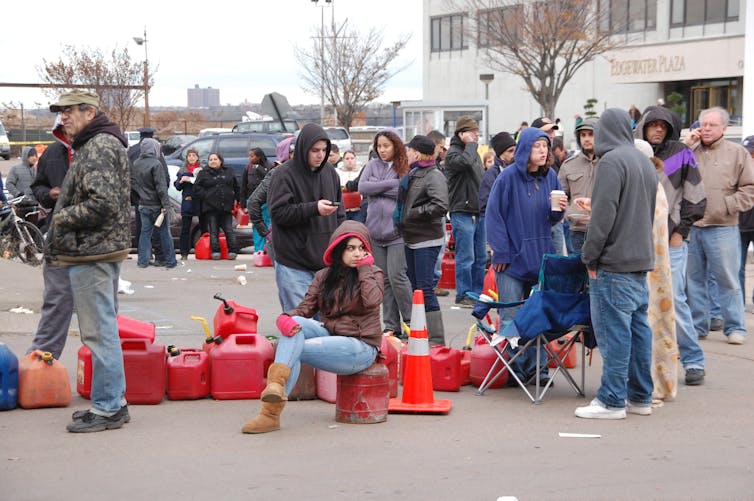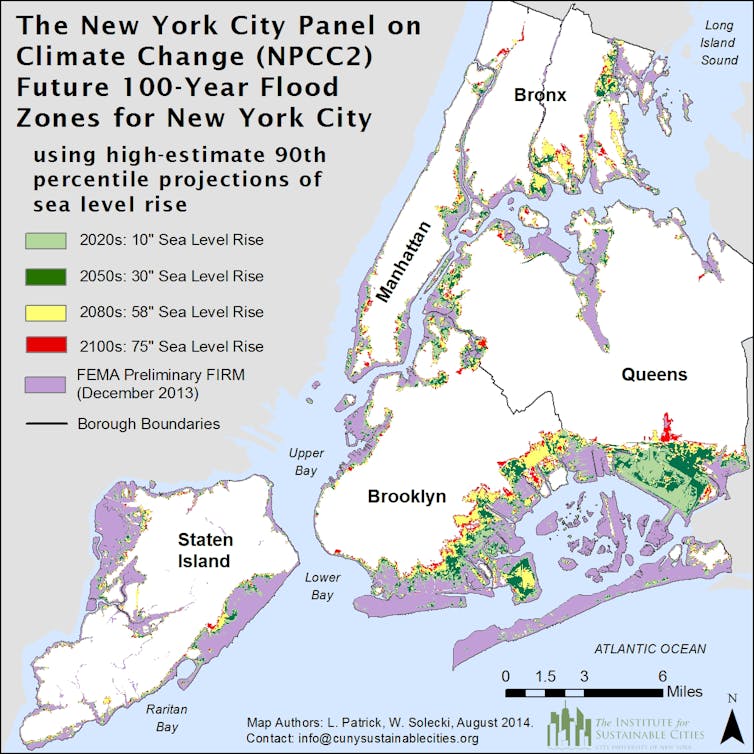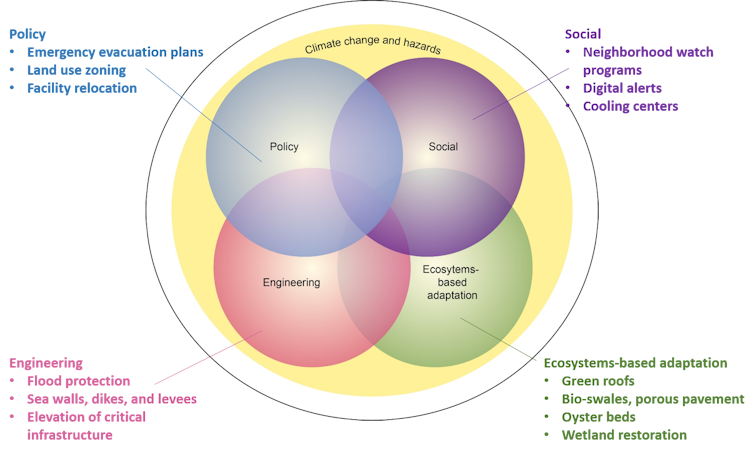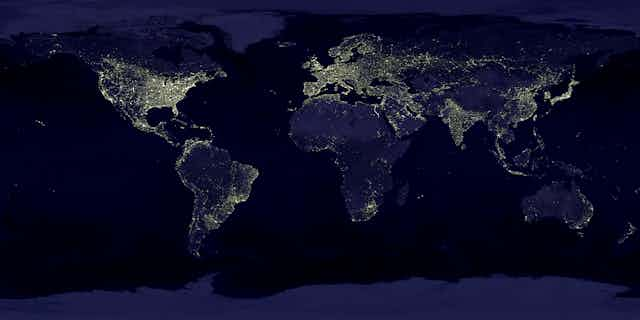We live in an urbanizing world. Up to two-thirds of the world’s population – some six billion people – may live in cities by 2050.
Cities have emerged as first responders to climate change because they experience the impacts of natural disasters firsthand and because they produce up to 70 percent of greenhouse gas emissions.
To protect urban dwellers from climate change impacts, such as more frequent and more intense heat waves, heavy downpours and coastal flooding, cities need to make themselves more resilient.
That’s why cities figured so prominently at the Paris climate conference last month, where hundreds of mayors pledged to reduce emissions and improve city resilience. As of today, 447 cities have signed on to the Compact of Mayors, a coalition of city leaders who have pledged to reduce greenhouse gas emissions, track progress and prepare for climate change impacts.
We codirect the Urban Climate Change Research Network (UCCRN), a group of over 600 experts who provide climate science information on adaptation and mitigation to urban leaders and practitioners from governments, the private sector, nongovernmental organizations and the community. At the Paris conference, the UCCRN released the Summary for City Leaders of its Second Assessment Report on Climate Change and Cities.
Based on our work with UCCRN, we believe that cities have great potential to lead on climate change solutions, but must be transformed in order to do so.
We also believe that New York City’s experience in rebuilding after 2012’s Hurricane Sandy offers useful lessons for other cities.
Adaptable plans
UCCRN has identified transformative strategies that cities can pursue to become climate leaders.
They should link preparations for near-term disasters and long-term climate change; meld activities that reduce greenhouse gas emissions and build resilience; involve multiple stakeholder groups and scientists in the planning process; focus on protecting the most vulnerable; enhance local credit worthiness and management skills; and look outward by joining city networks.
New York City is already pursuing these objectives, motivated largely by the damages it has already suffered from extreme weather.
On October 29, 2012, Hurricane Sandy hurtled ashore in the New York metropolitan region, killing 44 people and causing US$19 billion in damages in New York City alone. The flood inundation zone in New York City encompassed approximately 88,700 buildings, which contained 300,000 homes and 23,000 businesses, and left two million people without electricity.

Sandy was a wake-up call that showed how vulnerable New York City was to extreme climate events. In its wake, city leaders resolved to take steps that would make New York stronger and more resilient in the face of climate change.
New York’s experience in rebuilding after Hurricane Sandy highlights three main messages that are transferable to other cities.
First, there is enough information to act on climate change today based on the best-available science. Cities can update their climate projections and urban climate change action plans as scientific understanding improves and city leaders learn more about resiliency, but there is no reason to delay climate action planning.
In New York City, the New York Panel on Climate Change (NPCC), a body of experts first convened by Mayor Bloomberg in 2008, developed a concept of Flexible Adaptation Pathways that the city adopted in its long-term planning. Originally conceived in London, this approach calls for agencies to start adopting resiliency measures immediately, monitor how well they work, and continually update their understanding of climate risk information and responses as the climate system and resilience actions evolve.
If cities do not start acting now, many of the world’s vulnerable cities and populations will endure significant impacts from heat waves, heavy downpours and coastal flooding due to sea level rise.
The second important priority is to plan across entire metropolitan regions. In preparing for climate change, the city of New York is taking an approach that encompasses the entire “infrastructure-shed” of the city.
For example, the New York City climate action task force includes regional transportation providers who manage the subways, buses, and railroads that run within and around the city into the extended metropolitan region. Plans must also consider how extreme droughts and inland floods can affect the watershed that supplies New York City’s drinking water.

Disasters and extreme events do not respect political boundaries, so steps to make cities more resilient cannot stop at city limits. Instead, they need to encompass the interconnected energy, water, transportation, telecommunications, sanitation, health, food and public safety systems that extend beyond municipal borders to the wider metropolitan region and beyond, including national and international supply chains.
New York City’s third key step is bringing together city decision-makers, infrastructure managers, citizens groups and other key actors with researchers to develop shared understanding of New York’s specific climate change vulnerabilities and climate science needs.
That’s because climate change will not impact every city in the same way. For example, some cities will be exposed to repeated and worsening droughts, while others may be more exposed to flooding or extreme heat events. Scientists and stakeholders need to work together to understand the risks that are relevant for each city so that they can find effective ways to prepare for climate change.
Critical vulnerabilities
The most critical vulnerability in New York City that Hurricane Sandy spotlighted is coastal flooding. Currently, an estimated 400,000 New York residents, 71,500 buildings and much of the city’s critical infrastructure are located within the 100-year flood zone – that is, the area that has a one percent chance of flooding in any given year. Sea levels in New York City are rising at almost twice the global average rate, and the NPCC projects that sea levels will continue to rise in the coming decades, which will put more residents, buildings and infrastructure at risk.

Coastal cities across the world are vulnerable to sea level rise and more intense coastal storms. And cities everywhere face risks including more frequent and more extreme heat waves and increasing heavy downpours.
Critical infrastructure systems in cities exposed to these changing hazards include energy, transportation, telecommunications, water and waste. These systems are interdependent, so impacts on one of them can cause cascading effects onto other infrastructure systems during an extreme event.
For example, Hurricane Sandy caused gas shortages in the New York metropolitan region: loading docks on the water were physically damaged, refineries and terminals lost power and pipelines shut down, making it impossible to receive or ship fuel.
This caused major failures in the gasoline supply chain, forcing drivers to wait in line at gas stations and limiting New Yorkers’ mobility. Fuel shortages also made it more challenging for ambulances to respond to emergencies, for utility workers to restore electricity and for relief workers to reach the hardest-hit areas of the city.
Certain groups of people in cities are disproportionately vulnerable. For example, more intense and longer-lasting heat waves threaten people with underlying health problems, the young and the elderly, and low-income residents.
Investing in resilience
The UCCRN recommends that cities should take a portfolio approach to investing in resilience measures that spreads resources across multiple categories. They include implementing citywide policies, such as upgrading building codes; hardening critical protective structures; investing in green infrastructure, such as green roofs and bioswales; and strengthening social safety nets.

In order to develop specific, localized climate action plans, stakeholders and scientists need to work together to learn about climate risks, brainstorm strategies and prioritize implementation. This process should include groups that represent a cross-section of the city’s population, including the most disadvantaged citizens, as well as the private sector.
The Paris Agreement signals a new era for climate change, and cities are generating positive energy for this new phase. Early-adopter cities such as New York need to continue to strengthen and share their actions and lessons learned.
Cities that have not yet started need to begin planning and preparing for climate change. The good news is that many urban leaders are committed to meeting these challenges, and there is a great deal of knowledge that researchers can share on how to proceed. By starting to plan and invest now, cities can lead the effort to avoid dangerous climate change and adapt to a warming world.


